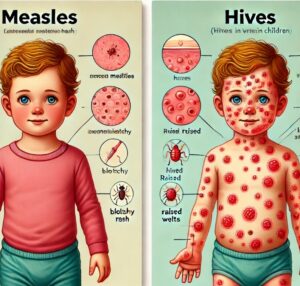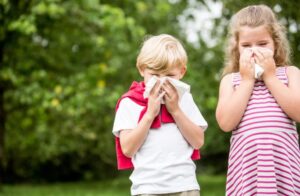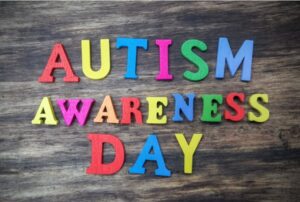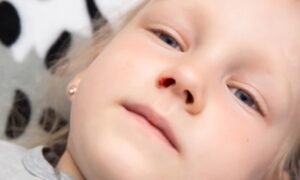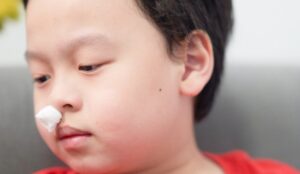Spring brings warmer weather and increased outdoor activities for children. However, it is also the peak season for chickenpox. The virus spreads easily in schools and daycare centers, making young children particularly vulnerable. While chickenpox is generally a self-limiting disease, improper care can lead to secondary infections or even severe complications.
Case Study: 5-Year-Old Nancy’s Chickenpox Experience
Nancy, a lively 5-year-old girl, loved playing outdoors with her friends in spring. One evening, she developed a low fever and complained of itchy skin. The next day, her mother noticed small red spots on her body, which quickly turned into fluid-filled blisters within hours. A doctor confirmed it was chickenpox, advising home isolation and proper care.
Despite her mother’s efforts, Nancy couldn’t resist scratching the blisters, leading to an infected wound that left a minor scar on her leg.
Key Takeaways for Parents:
- Early detection of chickenpox symptoms is crucial for timely action.
- Proper home care can reduce discomfort and prevent complications.
- Vaccination is the best preventive measure, significantly reducing infection risk and severity.
What Is Chickenpox?
Chickenpox is an acute infectious disease caused by the varicella-zoster virus (VZV). It is characterized by an itchy rash with blisters and is highly contagious. Children who haven’t had chickenpox or haven’t been vaccinated are at the highest risk of infection.
Symptoms of Chickenpox
Chickenpox progresses through the following stages:
- Early Symptoms: Mild fever, fatigue, loss of appetite—similar to a common cold.
- Rash Development:
- Red spots appear.
- Spots turn into fluid-filled blisters, causing severe itching.
- Blisters burst and scab over before healing.
- Incubation Period: 10-21 days.
Contagious period: A person can spread the virus 1-2 days before symptoms appear until all blisters have scabbed over.
How Chickenpox Spreads
The virus spreads through:
- Airborne transmission (coughing, sneezing)
- Direct contact (touching the blisters of an infected person)
- Contaminated objects (sharing towels, toys, or clothes)
Highly contagious: A single infected child can spread the virus to 90% of unvaccinated close contacts.
Treatment & Home Care for Chickenpox
General Care
✔ Keep skin clean to prevent infections.
✔ Wear loose, breathable clothing to reduce irritation.
✔ Relieve itching with calamine lotion, oatmeal baths, or antihistamines.
✔ Hydration & nutrition: Encourage fluids and a balanced diet to boost immunity.
Managing Fever
Recommended: Acetaminophen (Tylenol) for fever relief.
Avoid Aspirin: It may cause Reye’s syndrome, a rare but life-threatening condition.
When to See a Doctor?
Seek medical attention if your child experiences:
- Skin infection (blisters turn red, swollen, or pus-filled)
- High fever lasting over 4 days or exceeding 39°C (102°F)
- Lethargy, difficulty breathing, or confusion
Chickenpox Vaccine & Prevention
Varicella Vaccine
Recommended schedule:
- 1st dose: 12-15 months old
- 2nd dose: 4-6 years old (boosts long-term immunity)
Effectiveness: Two doses provide over 90% protection against chickenpox. Even if infection occurs, symptoms are much milder.
Everyday Prevention Tips
- Avoid contact with infected individuals.
- Practice good hand hygiene (frequent handwashing).
- Maintain a strong immune system with proper nutrition and sleep.
Potential Complications of Chickenpox
- Skin infections (caused by scratching blisters)
- Pneumonia or encephalitis (rare but serious complications)
- Shingles (Herpes Zoster): The virus may remain dormant and reactivate later in life.
Frequently Asked Questions (FAQs)
Can chickenpox recur?
No, but the virus can remain dormant and cause shingles later in life.
How long should children stay home from school?
Until all blisters have scabbed over (~1-2 weeks).
Can medication speed up recovery?
Most children recover naturally. However, antiviral drugs (Acyclovir) may be prescribed for immunocompromised children.
Will chickenpox leave scars?
Generally not, unless blisters become infected due to scratching. Proper care can minimize scarring.
Key Takeways
Spring is peak season for chickenpox outbreaks. Parents can protect their children by ensuring vaccination, maintaining good hygiene, and providing proper care if infection occurs. If your child contracts chickenpox, avoid scratching, keep them comfortable, and monitor for complications. With the right care, children can recover quickly and safely.
References
- Centers for Disease Control and Prevention (CDC). Chickenpox (Varicella): Overview & Prevention. https://www.cdc.gov/chickenpox
- Mayo Clinic. Chickenpox: Symptoms & Treatment. https://www.mayoclinic.org/diseases-conditions/chickenpox
- World Health Organization (WHO). Varicella and Herpes Zoster Vaccination. https://www.who.int/news-room/fact-sheets/detail/chickenpox
- American Academy of Pediatrics (AAP). Managing Chickenpox in Children. https://www.healthychildren.org




